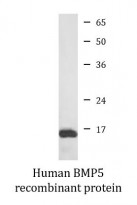ARG70090
Human BMP5 recombinant protein (Active) (His-tagged, C-ter)
Human BMP5 recombinant protein (Active) (His-tagged, C-ter) for SDS-PAGE
Overview
| Product Description | E. coli expressed, His-tagged (C-ter) Active Human BMP5 recombinant protein |
|---|---|
| Tested Application | SDS-PAGE |
| Target Name | BMP5 |
| Species | Human |
| A.A. Sequence | Val341 - His454 |
| Expression System | E. coli |
| Activity | Active |
| Activity Note | Determined by its ability to induce alkaline phosphatase production by ATDC5 cells. The ED50 for this effect is < 0.17 μg/mL. |
| Alternate Names | BMP-5; Bone morphogenetic protein 5 |
Properties
| Form | Powder |
|---|---|
| Purification Note | Endotoxin level is less than 0.1 EU/µg of the protein, as determined by the LAL test. |
| Purity | > 98% (by SDS-PAGE) |
| Buffer | 20 mM sodium citrate and 0.2 M NaCl (pH 3.5) |
| Reconstitution | It is recommended to reconstitute the lyophilized protein in 4 mM HCl to a concentration not less than 200 μg/mL and incubate the stock solution for at least 20 min at room temperature to make sure the protein is dissolved completely. |
| Storage Instruction | For long term, lyophilized protein should be stored at -20°C or -80°C. After reconstitution, aliquot and store at -20°C or -80°C for up to one month. Storage in frost free freezers is not recommended. Avoid repeated freeze/thaw cycles. Suggest spin the vial prior to opening. |
| Note | For laboratory research only, not for drug, diagnostic or other use. |
Bioinformation
| Gene Symbol | BMP5 |
|---|---|
| Gene Full Name | bone morphogenetic protein 5 |
| Background | This gene encodes a member of the bone morphogenetic protein family which is part of the transforming growth factor-beta superfamily. The superfamily includes large families of growth and differentiation factors. Bone morphogenetic proteins were originally identified by an ability of demineralized bone extract to induce endochondral osteogenesis in vivo in an extraskeletal site. These proteins are synthesized as prepropeptides, cleaved, and then processed into dimeric proteins. This protein may act as an important signaling molecule within the trabecular meshwork and optic nerve head, and may play a potential role in glaucoma pathogenesis. This gene is differentially regulated during the formation of various tumors. [provided by RefSeq, Jul 2008] |
| Function | Induces cartilage and bone formation. [UniProt] |
| Cellular Localization | Secreted. [UniProt] |
Images (1) Click the Picture to Zoom In






